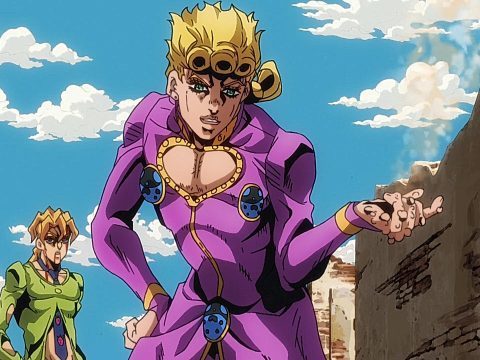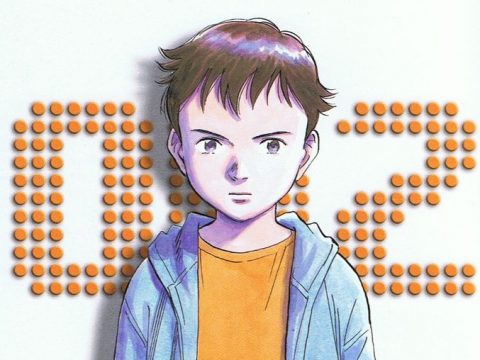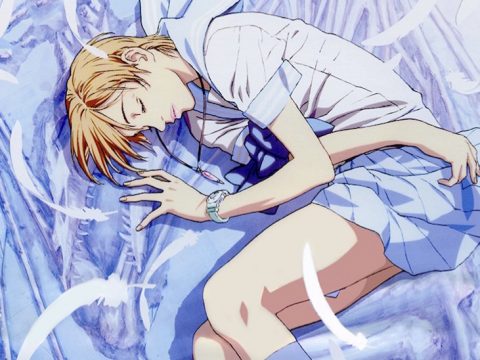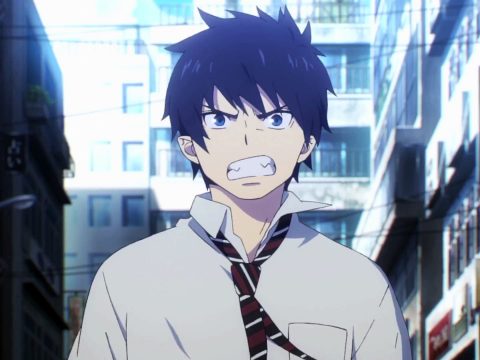 The American public education system doesn’t teach anything about Japanese history, so all that I—and most US anime fans—know about the subject is what is conveyed within pop culture, and most of that focuses on samurai or ninja since they’re the ones with the sharp pointy metal things. I suppose the Japanese equivalent of this is how they aren’t really taught the details of what Adolf Hitler did, which is why they don’t really see why dressing up as a Nazi is such a bad thing, but as proof of my relative ignorance I never even heard the phrase “sengoku jidai” until I was 20, when the videogame Shogun: Total War was released. And that’s a British-developed game! The sequel finally comes out next year; please don’t mess it up, Creative Assembly.
The American public education system doesn’t teach anything about Japanese history, so all that I—and most US anime fans—know about the subject is what is conveyed within pop culture, and most of that focuses on samurai or ninja since they’re the ones with the sharp pointy metal things. I suppose the Japanese equivalent of this is how they aren’t really taught the details of what Adolf Hitler did, which is why they don’t really see why dressing up as a Nazi is such a bad thing, but as proof of my relative ignorance I never even heard the phrase “sengoku jidai” until I was 20, when the videogame Shogun: Total War was released. And that’s a British-developed game! The sequel finally comes out next year; please don’t mess it up, Creative Assembly.
The “sengoku jidai,” which means something like “age of the country at war” or “the warring states period,” lasted for roughly a century and is one of the most popular periods to set Japanese historical fiction. It was a feudal era prior to Japan’s national unification; the age of samurai, with multiple sides at war with one another amidst the early introduction of Catholicism to Japan by way of seafaring trade… and with it, gunpowder. On top of the big battles there were all sorts of alliances and back stabbings afoot, replete with intelligence espionage and spying. No wonder this timeframe allows one to create stories about samurai warriors, ninja, geisha, and of course being a foreign dude who becomes a ninja, fights with samurai, and sleeps with the geisha! Among current anime fans, perhaps the most high-profile example of the Sengoku period is the anime and videogame series Sengoku Basara, which manages to be fujoshi catnip AND over-the-top awesome at the same time. Expect some stories on that one in future issues of Otaku USA. But 20 years ago, there was another which captured much of the same spirit, and chances are high that you might have never even heard of it.
Fans of Sengoku Basara may already know of Keiji Maeda (1541-1612). In that, he’s a guy with a pet baby monkey, a giant horse, and this enormous erm…sword. Like most of the cast, Keiji Maeda was actually a real-life person, and due to his numerous life achievements has been frequently mythologized in his cultural depictions. It’s nowhere near the level of the man he once served under, Oda Nobunaga, who depending on which anime or videogame you’re seeing him in is either an evil cyborg, space alien, or demon hellspawn. Yet you could still fill books with Keiji’s exploits…and people have!

Hana no Keiji was a Weekly Shonen Jump manga which was released in the US under the shortened title Keiji in 2003, but despite being written for elementary school to middle school-aged Japanese boys it wasn’t published within the pages of the US Shonen Jump. Instead, this boy’s manga was serialized in America within the manga anthology Raijin Comics, which bore a FOR MATURE READERS label on every cover. The reason for the publication changeover ultimately boils down to Japanese creators owning their work instead of the publishers. One look at the artwork will tell you that Keiji was drawn by Fist of the North Star artist Tetsuo Hara who is a co-founder of Coamix, the company that effectively owned Raijin Comics. As Coamix is a competitor to Shueisha, the Japanese company that publishes Jump, neither side would have ever permitted this comic to run in the US Shonen Jump. But man, just imagine the glory if it had…

Keiji is a… shall we say, EMBELLISHED… biographical tale of Keiji Maeda that was… loosely… adapted by scriptwriter Mio Aso from a novel by Keiichiro Ryu, who’s written quite a few historical fictionalizations of real-life figures from the Sengoku period. It starts in 1584, two years after the death of Oda Nobunaga. With Nobunaga out of the picture, Keiji is now a “kabukimono”: a flamboyantly dressed ronin who eschews manners and social grace for the sake of “bringing beauty to his life.” [Translation: being FABULOUS.] The free-spirited kabukimono is the opposite of the duty-bound samurai: living by their own code of morality, going where they pleased, and doing what they wanted. If you were Erin Finnegan and just read that sentence, you would be thinking “aha, the very embodiment of Chaotic Good!” you NERRRRRD! Kabukimono harbored little respect for the law, causing trouble as they saw fit while wearing the silliest outfits imaginable. Remember: these people really existed! Perhaps kabukimono are where the notion of “once you’re a tough enough dude, you can wear WHATEVER YOU WANT because nobody can mess with you” came from. For more on this concept in action, refer to Jojo’s Bizarre Adventure.
You can instantly tell that Keiji abides by this law of Bohemian pimp-dom, as his first appearance is a two-page, full color spread detailing him smoking out of a gold pipe and drinking with six girls at the same time on the upper floors of a brothel while wearing a multicolored fur coat very similar to what he wore in Sengoku Basara. So it has to have been real, right? Like all chief protagonists drawn by Tetsuo Hara, Keiji himself looks exactly like Kenshiro from Fist of the North Star, sans the permanent scowl and with a different hairstyle. Within moments he’s fighting against hordes of black ninja and rival kabukimono who—shockingly!—happen to look exactly like Fist of the North Star thugs only in ninja/samurai gear or wearing crazy kimonos replete with giant feathers. His first major opponent cuts off people’s ears and forces children to carry them around in a wooden pail. Hey, ordinary evil just isn’t enough to warrant the level of annihilation the bad guys in a Tetsuo Hara-illustrated manga receive! This is all in Chapter 1, and it only gets crazier from there. Throughout the first few volumes, Keiji’s troubles can be traced back to his adopted uncle Toshiie Maeda (much older than he is in either Samurai Warriors or Sengoku Basara due to the time period), who for the sake of this story at least is jealous of Keiji on account that Toshiie’s much younger wife Matsu—who really did marry him when she was 12 and gave birth to ELEVEN kids—has the hots for Keiji instead of him. Lady Matsu, in keeping with all the women Tetsuo Hara draws, is smokin’ hot.

Keiji Maeda is also remembered for owning a particularly powerful war horse named Matsukaze, though perhaps the historical record forgot to point out that Matsukaze’s stomps cause entire sections of cliff faces to crumble onto his foes below or his kicks dismember battalions at a time. Tetsuo Hara basically transplanted Raoh’s horse Kokuoh-go (“Black King”) from Fist of the North Star to here for the sake of HISTORICAL ACCURACY. What may be less accurate is how in addition to being a kabukimono, ladies man extraordinaire, exceptionally strong swordsman, and commander of a colossal steed upon which he cleaves through the hordes using a gargantuan spear, in this manga Keiji is also a Kouga ninja. Hey, when you live a life in which random old ladies keep nine vipers hidden up their sleeves ready to throw in your face, or you’re assailed by shape-shifting ninja and a guy with a rocket-powered bladed prosthetic fist on chains, you NEED to be able to protect yourself. In the words of Sho Kosugi, only a ninja can defeat a ninja…and some ninja attack using swarms of bats hopped up on opium that have kunai strapped to them! (If you eat those bats live then YOU can get hopped up on opium too!)
Shonen Jump titles can get canceled within 3 chapters if they’re not deemed popular enough based on reader survey responses, but Hana no Keiji (“Flowery Keiji”) was popular enough to run for four years across 18 volumes. Upon its completion in 1993 it was replaced by Rurouni Kenshin the following year as the de facto Shonen Jump samurai comic, which went on to become one of the most popular anime and manga titles of the 1990s (and then some). For more on that, refer to my feature in the August 2010 issue of Otaku USA! The notion of a guy who lives in complete freedom and has the power to protect that freedom is something that has widespread appeal. (Well, that and having a pet monkey that obeys your commands, but unlike in Sengoku Basara, it’s fully grown, not a baby. Historically, Keiji really did have one, and he really DID dress it up in silk robes, but I’m pretty sure that’s an orangutan since monkeys have tails!)
What does NOT have widespread appeal, at least not anymore, is the level of graphic violence. As one would expect from the same artist who’d completed Fist of the North Star prior to starting this, the violence level in Keiji is substantial. Every swing of the sword or spear results in graphic dismemberment. People are routinely cut either in half or thirds (or more), and heads are cleaved through the jaw line or face as often as they are through the neck. Guts spill out from slit stomachs and eyeballs pop out of severed heads just because. Tetsuo Hara LOVES drawing that one eyeball flying out of a guy’s head, even if no direct trauma to the skull is inflicted by the wound that killed them. That’s not as prevalent in the early going, but it’s no wonder this couldn’t appear in the pages of the US Shonen Jump. To be fair, it’s not like anything of this caliber has run in the Japanese weekly edition either. I for one can’t recall Ichigo Kurosaki from Bleach ever taking that giant sword of his, slicing someone open from chin to crotch, then reaching into the wound to pull out and inspect their split open empty stomach to determine that yes, the enemy’s food rations ARE exhausted.

I suppose I may as well get this out of the way: just because a whole lot of the events, characters, and general madness levels are awfully similar between Keiji and Sengoku Basara doesn’t mean that fans of one may necessarily like the other. The key missing element between Keiji and Sengoku Basara is the lack of appeal to the fujoshi demographic: girls/women who enjoy stories about gay male romance that constitute a substantially high percentage of US/JP fans of anime and manga. In addition to the fact that the ladies are by and large turned away from violence this detailed, the inherent homoeroticism of the samurai lifestyle is depicted entirely too overtly and matter-of-fact in Keiji for the yaoi crowd to have any fun with the concept. Oh sure, Keiji lives up to his name when he brings his childhood male friend Okumura Suke-emon flowers, which reminds them of their childhoods spent together rolling around on the floor together shirtless. But then “to raise troop morale,” they both drop their pants and urinate on the 15,000 man army besieging the castle they’re occupying (Suemori Castle if you want to look it up!), even though Okumura is severely wounded and bleeding profusely. Keiji then compliments Okumura for being “as well armed as me!” since the mark of a REAL MAN is the ability to get it up on the battlefield. As the narrator plainly states, “most men’s swords were not even daggers in battle, but as proof of his firm resolution, Keiji’s manly nature rose to the occasion.”

Another strike against Keiji in this regard is its artwork: those thick eyebrows, prominent displays of post-pubescent secondary sex characteristics, and on-panel depictions of [really large but blocked out] penises simply won’t fly among modern-day fujoshi, who demand that homosexuality be present in stories for boys in elementary to middle school albeit UNDERSTATED and IMPLIED; “a subtle yaoi element” as Jason Thompson would say. Key word being “subtle”: nobody is inspired to buy chibi merchandise and craft smut doujinshi work when elderly Toshiie Maeda straight-up disrobes and asks a young male page to “join me in my bath” thus prompting the narrator to explain how historically, some warlords retained young men to attend to their sexual needs! Well, just RUIN THE FUN OF IT why don’t you! Note: this being a Shonen Jump title, no actual sex of any kind is ever shown on panel. Unless you count people’s junk getting grabbed. That happens fairly often.
Keiji has everything I want in a manga. Outrageous violence (some of which even involves monofilament wire!), even more outrageous ninjanigans—REAL NINJA consensually deflower a buxom kunoichi in the treetops after she’s stabbed them in the shoulder for killing her fiancé—people crying manly tears, wacky hijinks, the occasional sexy lady, telepathic conversations with horses, and just enough historical accuracy that you might actually learn something thanks to Tetsuo Hara’s painstaking dedication to making sure everything looks right along with actual characters and events being used as the narrative framework. Despite its near-total unknown status in the US—not enough of “the gay” for the female moe fans, not enough of Keiji’s little girl traveling compatriot Ofu for the male moe fans—in the twenty years since it began there have been multiple spinoff titles to Keiji drawn by Tetsuo Hara, some of which were made as recently as a few months ago. That’s some serious longevity right there. About ten years ago I purchased the complete Japanese run of another, more seinen-oriented Tetsuo Hara-illustrated ninja/samurai manga called SAKON, which is 6 volumes of absolute insanity that blows everything I just wrote about Keiji out of the water. You haven’t lived until you’ve seen a two-page spread of a wall made entirely of black ninja. If only I could read the words…
 “If only I could read it” is hopefully what some of you are thinking now, but unfortunately there’s little chance you’ll be able to do so. Only 26 chapters of Keiji were translated into English before Raijin Comics ceased publication in 2004. (At the time of writing, Wikipedia says 24 chapters. I’m right, it’s wrong; don’t rely on Wikipedia for research, kids!) None of the 18 volumes of Keiji released in Japan was ever released in compiled manga form in America. No US manga publisher has since picked it up for release, and to my knowledge no English-speaking fans have ever released their own fan translations of Keiji or any of its follow-ups. There aren’t even pictures from it on the Web; I had to [poorly] scan these in myself! In short, you can’t get it in English unless you happen to possess copies of a magazine published nearly a decade ago which hardly anyone besides me bought even as it was coming out. But the issues are out there on eBay and the like. Fans have gotten so used to getting things with the click of the mouse that hardly anyone wants to put forth effort for the good stuff when “good enough” is so much easier to come by. Well, get to it, otaku! I promise you won’t regret it.
“If only I could read it” is hopefully what some of you are thinking now, but unfortunately there’s little chance you’ll be able to do so. Only 26 chapters of Keiji were translated into English before Raijin Comics ceased publication in 2004. (At the time of writing, Wikipedia says 24 chapters. I’m right, it’s wrong; don’t rely on Wikipedia for research, kids!) None of the 18 volumes of Keiji released in Japan was ever released in compiled manga form in America. No US manga publisher has since picked it up for release, and to my knowledge no English-speaking fans have ever released their own fan translations of Keiji or any of its follow-ups. There aren’t even pictures from it on the Web; I had to [poorly] scan these in myself! In short, you can’t get it in English unless you happen to possess copies of a magazine published nearly a decade ago which hardly anyone besides me bought even as it was coming out. But the issues are out there on eBay and the like. Fans have gotten so used to getting things with the click of the mouse that hardly anyone wants to put forth effort for the good stuff when “good enough” is so much easier to come by. Well, get to it, otaku! I promise you won’t regret it.






![[Review] Ghost in the Shell Deluxe Edition Manga [Review] Ghost in the Shell Deluxe Edition Manga](https://otakuusamagazine.com/wp-content/uploads/2017/08/gitsdeluxeheader-480x360.jpg)
